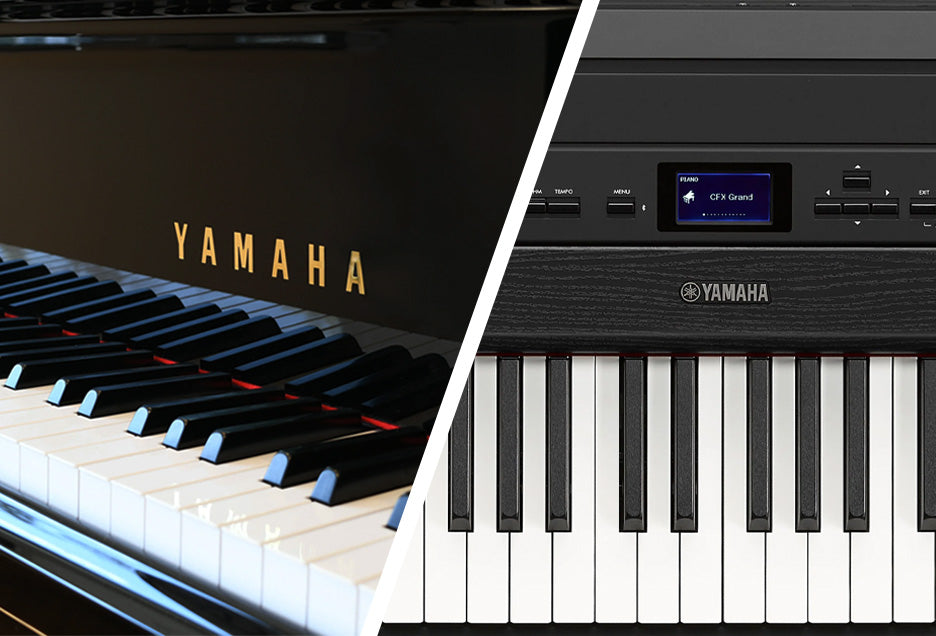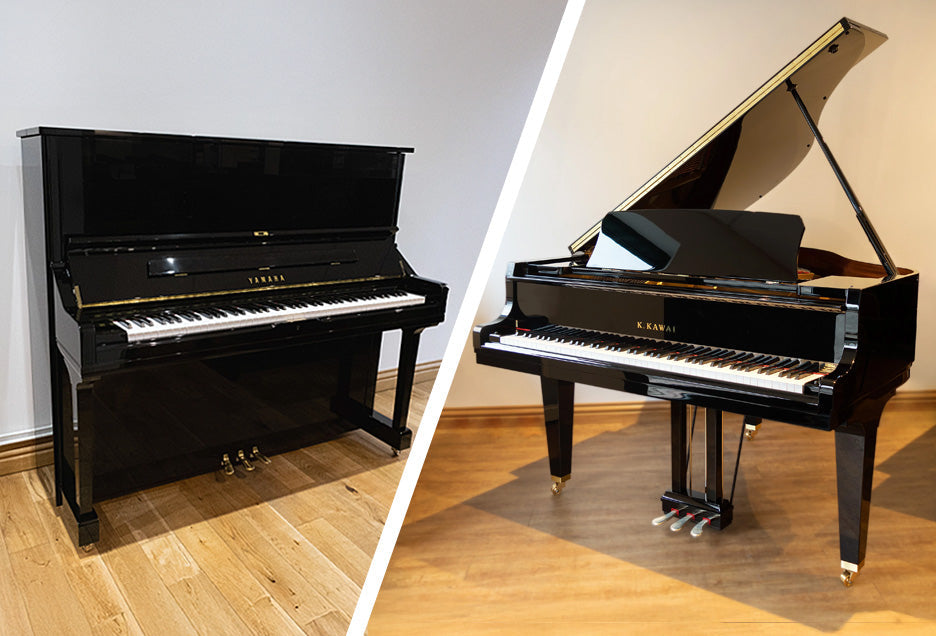Modern pianos are fabulous. They are technically efficient machines and ongoing advances in manufacturing techniques, materials, and machinery mean that they should last for decades without major repair. For instance, companies such as Yamaha and Kawai can machine a component to a fraction of a millimetre, a feat that just wasn’t possible a hundred years ago. Additionally, wood can be dried to a decimal point specific level of moisture content to ensure optimum stability.
However, there’s no denying that older pianos do have a certain beauty. A piano is an instrument first, but also a piece of furniture for your home and sometimes a modern, black and shiny grand piano just doesn’t fit with the chosen aesthetic. Older instruments often have wonderful wood veneer finishes with a depth of colour and patina which simply can’t be replicated by manufacturers today, along with period features such as a carved filigree music desk and turned legs. While manufacturers such as Steinway and Blüthner produce incredible special editions with many of these historic features, these come at a premium and can cost many hundreds of thousands of pounds.
We source our restored Steinway, Bluthner, and Bechstein pianos in the UK, where in many cases they have been a much-loved family instrument passed down through generations. Often in rather a sorry state these pianos are shipped to our restoration partners for a comprehensive rebuild; a process which takes between six and twelve months. Wherever possible our pianos are restored using only genuine manufacturer components, to ensure the piano sounds and plays just as the original manufacturer intended. Many of our restorer’s technicians have trained in manufacturer workshops, enabling them to bring new piano manufacturing expertise to the rebuilding of these historic models.
As the restoration commences, the piano is stripped down with the action, frame, and soundboard removed.
Cabinetry
The original finish is carefully removed before any faded or damaged veneers are repaired as necessary. Damaged or missing parts are repaired or replaced too, with replacements either sourced from the original manufacturer, or bespoke made to the same pattern if unavailable. The cabinetry is then sprayed in a high gloss, clear polyester lacquer which is then sanded down to a smooth finish and buffed to create a lustrous shine.
For those instruments whose appearance is being modernised, the cabinetry altered as required with a modern style manufacturer logo applied and finished in a high gloss black polyester lacquer. Often modernisation also includes the fitting of new, square tapered or spade legs and pedal lyre, with a sostenuto pedal added for good measure.
Soundboard
We always retain the original soundboard; this is, after all, the beating heart of the piano. Retaining this component helps us retain as much of the original instrument’s character as possible, enabling the piano to deliver a mature and resonant tone. If the soundboard is cracked it is repaired using wooden shims before being refinished, then the ribs refitted and reinstalled into the piano. It is at this point that the manufacturers decal is applied to the soundboard as the final finishing touch.
Bridges
The bridges are a crucial component, transferring the vibration of the strings into the soundboard. A piano’s strings are woven across the bridge through the bridge pins which are angled so that, when under tension, the strings are pushed against the bridge to ensure none of the energy is lost. The condition of the bridges is critical to the integrity of the sound, so they are either restored or replaced, depending on the condition of the originals. When replaced, the new bridge caps are fitted and shaped by hand to ensure they match the originals.
Pin block
While the soundboard amplifies the tone, the pin block keeps the piano in tune. A cracked pin block renders a piano useless, while many tons of pressure on the pins can cause them to loosen over time. If the pin block is not cracked, it is possible to re-pin a piano using wider pins, immediately improving the tuning stability. Ordinarily, we opt for a new pin block to ensure ongoing tuning stability for many years to come, which is fitted into the piano prior to the cabinet refinishing.
Cast iron frame
One of the key developments in piano design in the 19th century was the introduction of the cast iron frame, resulting in huge improvements to stability and reliability. The frame must resist up to 30 tons of pressure, and it is crucial that the frame is not compromised otherwise the piano will not remain in tune. For instance, it is quite common for the frames in older Bechstein pianos to develop cracks, so each frame is assessed and repaired as necessary. Over many years the gilding on the frame becomes faded and dirty, so they are sand blasted back to the bare metal and refinished, with the detailing hand painted.
Stringing
Once the soundboard and cabinet have been refinished, the bridges repaired or replaced, and a new pin block fitted, the frame is reinstalled into the piano. New strings are then made and fitted, using all genuine new stringing felts, agraffes, duplexes and nickelled tuning pins.
Keyboard & action
It is so important that the keyboard is even, responsive and accurately reproduces the intention of the musician. As a piano’s mechanism and hammers gradually wear out, we specify that all our pianos have a brand new top-action: for Steinway pianos a new action is sourced from Steinway Hamburg, while for Blüthner and Bechstein pianos a combination of Renner and Abel components are used, as they are by Blüthner and Bechstein today. Once the action is painstakingly fitted into the instrument and the strike point adjusted so that the strings are struck correctly, the keys are re-weighted to ensure a well-balanced and responsive touch, while the original ivory and ebony key surfaces are restored whenever possible.
Dampers
The dampers drop back onto the strings whenever a note is released in order to stop the note from sounding. These components need to work in harmony with the action so that they lift and drop at exactly the correct time and don’t impede the quality of the pianist’s performance. All the perishable components within the damper mechanism are replaced and the system is regulated so the dampers lift and drop evenly, particularly when pedalling.
Regulation and voicing
Once the piano has been reassembled, each note is adjusted to ensure optimum performance and tonal quality. Freshly fitted ‘raw’ hammers are particularly unyielding, so they are voiced using fine needles to ensure uniformity across the keyboard. Our own technicians carry out further voicing and regulation works at our showroom as the piano settles to prepare the instrument for sale. Voicing can also be carried out as part of our bespoke setup service, as we customise the sound and feel of the piano to our client’s musical requirements.
Warranty
Our restored pianos are of the finest quality, and we are confident that they will deliver musical enjoyment and reliable service for generations to come. Each piano is supplied with a five-year warranty, covering parts and labour in the event of a defect in workmanship or materials used as part of the restoration process.



